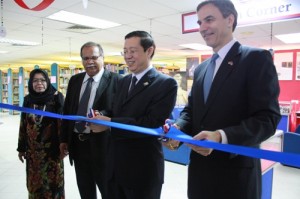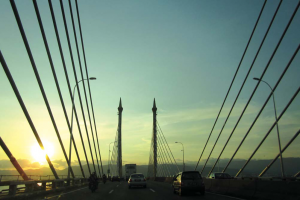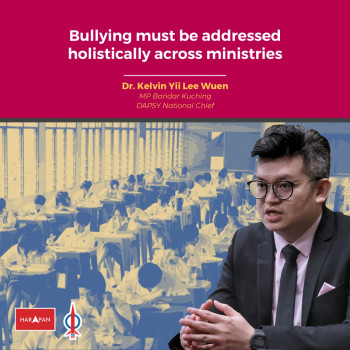by Karl Lee
In this new era of ‘Third Industrial Revolution’ where niche products are invented, produced and sold according to particular clientele needs, human capital has been the single most important factor for companies and countries aspiring to climb up the economic ladder. For a country mired in middle-income trap, Malaysia now appears at the crossroads between adopting the knowledge-intensive, high value-added and talent-driven economy and continuing the unsustainable age-old economic model characterised by export-oriented, low-end manufacturing, labour intensive mass production and low wages.
As for Penang, the jewel that shined in the past decades as an electronic production hub, it now faces the same challenge which besieged its federal counterpart. Unlike the greater Malaysian federation however, Penang is actually well-positioned as a hub to attract, develop and retain niche and wide-ranging talents for several good reasons.
Building State-of-the-Art Infrastructure: Attracting Talents in Industrial Research
While the state government lacks the sizable federal government-kind of financial resources to provide generous research funds to highly-qualified researchers, it has pursued a strategy where private industrial players can fill the vacuum by taking up the role of financial sponsor in industrial research. The current Penang government diverted considerable state funds to the establishment of the Penang Tech Centre and the expansion of the Penang Science Park.
A piece of land worth RM100 million in the Bayan Lepas Industrial Area had been set aside for the Tech Centre and which upon completion of construction works, will function as a one-stop centre for corporate participants to host their research and development (R&D) initiatives and showcase their inventions to the respective audience. The latter which was built in 2006 to attract new investments for the biotechnology industry, is also undergoing expansion after the newly installed Pakatan Rakyat (PR) state government decided to continue with the project with an additional 49.3ha plot of land in Juru.
Such model of public-private partnership in which the state supplies high-tech facilities while the private sector the needed funds, is undoubtedly the most viable and economic form of development policy out of the current circumstance. More importantly, it helped to brand Penang as a private sector-talent hub and clearly distinguished itself from our neighbour, Singapore, which possesses much more financial capacities and policy freedom to support their rush for talent.
Private-Driven Innovation Programs: Cultivating and Retaining Young Talents with Niche Skills
 In an effort to make up for the financial constraint in public scholarship offerings and policy inflexibility resulting from Putrajaya’s centralised educational policy, the Penang government subsequently established the Penang Science Council in 2010. Tasked in seeding the seeds of innovation in science and technology and grooming future talents among our younger generation, the PSC has progressed through its first year with encouraging signs.
In an effort to make up for the financial constraint in public scholarship offerings and policy inflexibility resulting from Putrajaya’s centralised educational policy, the Penang government subsequently established the Penang Science Council in 2010. Tasked in seeding the seeds of innovation in science and technology and grooming future talents among our younger generation, the PSC has progressed through its first year with encouraging signs.
The First Lego Robotics Program and the First Design Competition held under the pillars of sustainable education and learning and innovation and research pillars, drew positive and remarkable participation among our young students in both schools and universities.
The successes also showed that despite low if not zero participation of the state authorities, private companies under the leadership of multinational corporations could play a central role in moulding our younger generation into highly-skilled professionals according to the present and future market needs.
For students, the programs helped to develop their special niche skills, something that our current schooling system is unable to provide. In the foreseeable future, too, there may be scholarships and other types of funding opportunities which university and school students can tap upon should their inventions, innovations and skills proved to be impressive and useful for private companies. In both ways, our young talents are cultivated and retained locally.
Enhancing Livability of the City: A Factor to Attract, Cultivate and Retain Wide-Ranging Talents across Industries
As stipulated in the Vancouver Declaration 1979 concluded during the First UN Human Settlements Conference, a livable settlement should take into account aspects such as local representation, recognition of heritage and culture, wide participation of the populace, innovative utilisation of science and technology for sustainable development, and fair economic opportunities to all. To support these goals, policies should be developed to achieve these goals through mobilisation of economic resources, institutional changes and international cooperation.
Though it is impossible for me to go through all of them here, I would like to highlight some of the policies which the PR-led state government has implemented in recent years in the path of driving Penang into a livable city for wide-range of talents in other industries.
Since the PR government took over the state power in 2008, there are notable changes in terms of public participation on government’s policies, freedom of speech and rights to demonstrate. Aware of the public concern about the Penang Local Plan, the state government organised a number of public forums throughout the island to provide information and engage the public about the controversial plan though it was approved well before PR moved into Komtar.
As part of efforts to let Penangites have a say on state and local policies, the state government also decisively ratified both Freedom of Information Enactment and Penang Local Government Enactment, the first state in Malaysia to do so. To those seeking democracy at its best, Penang is definitely an excellent option to live.
 Then, in terms of Competency, Accountability and Transparency (CAT) governance, Penang became the first state government to be praised by Transparency International (TI) for implementing the long awaited open tender system on public contracts of more than RM 200,000. Through such move, a total of RM 125 million worth of jobs have been created and more surprisingly, Malay contractors won 69.81% of tender bids as evidenced in the recent March 2008 to August 2011 figures by the Penang Development Corporation (PDC).
Then, in terms of Competency, Accountability and Transparency (CAT) governance, Penang became the first state government to be praised by Transparency International (TI) for implementing the long awaited open tender system on public contracts of more than RM 200,000. Through such move, a total of RM 125 million worth of jobs have been created and more surprisingly, Malay contractors won 69.81% of tender bids as evidenced in the recent March 2008 to August 2011 figures by the Penang Development Corporation (PDC).
As noted by Zairil Khir Johari in his Penang Monthly article Entering New Terrain with Open Tenders, such transparent policy heightened business confidence among investors and in 2010 alone, Penang’s foreign direct investments (FDI) accounted for RM 10.5 billion, 86.1% out of total investment of RM 12.2 billion.
Despite dropping to RM 9.1 billion in 2011 as shown in Malaysian Investment Development Authority (MIDA) latest data, Penang still surpassed Johor, the southern state that the Najib administration hoped to seal about RM 65.8 billion worth of projects in line with its Economic Transformation Program (ETP), as the state with the most FDI and total investment for that whole year.
Furthermore, the chief minister has revealed that for the first three months of 2012, more and more foreign companies are now investing on knowledge-intensive, advanced and high value-added products with the likes of next generation multilayer printed wired board, renewable energy, aerospace, medical devices, and life sciences. In the long run, such scenario would generate more high-end jobs in the state, the main prerequisite in attracting specialised-skilled professionals and uplifting the current middle-income trap.
Finally, Penang is famous for its heritage sites and culture. The listing of George Town as a UNESCO World Heritage Site (WHS) alongside Melaka served to confirm that status. Two entities, World Heritage Office and Penang Global Tourism (PGT) were subsequently set up to manage and brand Penang as a heritage and cultural haven while projects under the George Town Transformation Programme (GTTP), a federal government’s concept under the Northern Corridor Economic Region (NETP), are set to re-vitalise the city through sustainable developments inclusive of heritage sites preservation and environmental protection.
Penang, too, is already on the world map as sports events hub as well as the Asian paradise for international art, music and cultural festivals. Besides, Penang is home to global and local activism with think tanks and NGOs such as Third World Network (TWN), Penang Institute, Penang Heritage Trust, and World Alliance for Breastfeeding Action (WABA), setting their headquarters in the state. And of course, not to forget the richness of food and the wonderful mesh of races and religions that formed Penang as it is today. There is no issue that Penang will score highly when comes to attracting and retaining talents in the fields of arts and social but also those in other sectors seeking a more balance life.
Hence, it is by no coincidence or a matter of luck that the ECA International’s annual location ratings had ranked George Town at the 8th best livable Asian city together with the giant metropolis of Seoul.
For the past four years or so, the PR-led Penang state government’s policies and mode of governance have injected a new lease of hope to ordinary Penangites and Malaysians who are aware of the seriousness of the brain drain phenomenon in our country. Frankly speaking, I am convinced this is the way forward for Penang and for Malaysia as a whole. Are you? -The Rocket




